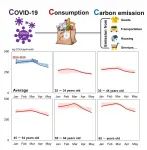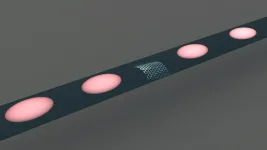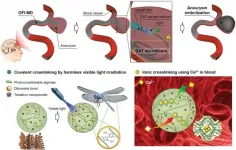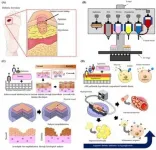(Press-News.org) Autistic people have far greater risks of long term physical health conditions than others, but the reasons for this remain unclear. New research from the University of Cambridge suggests that unhealthy lifestyle habits may be an important contributing factor. The results are published today in the journal Molecular Autism.
Earlier research suggests that autistic people die 16-35 years younger than expected, and that greater health problems may contribute to this risk. The present study is the first to consider the diet, exercise, and sleep patterns of autistic adults and how these patterns may relate to health outcomes.
The team at the Autism Research Centre in Cambridge developed an anonymous, online survey about lifestyle choices and daily habits, personal medical history, and family medical history. The final study included 1,183 autistic adults and 1,203 non-autistic adults aged 16-90 years.
The results showed that autistic adults were far less likely than non-autistic adults to meet very minimal health recommendations for diet, exercise, and sleep. Autistic adults were also far more likely to have atypical eating patterns (including limited diet) and sleep disturbance. They were more likely to be underweight or obese than non-autistic individuals.
These poor lifestyle habits were associated with greater risk of cardiovascular conditions such as high blood pressure, heart disease, and stroke among autistic males, and this was a stronger association even than a family history of a cardiovascular condition. Though it is not possible to say conclusively that a poorer lifestyle led to cardiovascular problems, the findings provide the first indication that promoting healthy choices regarding diet, exercise, and sleep may help to reduce the excess risks of health conditions in autistic adults.
While the results indicate that there may be other biological or environmental factors that leave autistic individuals at greater risk of health conditions, they also provide a clear target for intervention. Difficulties with maintaining a healthy lifestyle may also have knock-on effects beyond physical health, including limiting opportunities for social interaction (which may centre around mealtimes or exercise), and could contribute to worsening mental health, and affect employment or education.
The lead researcher of the study, Elizabeth Weir, a PhD student at the Autism Research Centre in Cambridge, said: "These findings help us to better understand the experiences of autistic adults, and have wider implications for quality of life. We need to understand the reasons for restricted diet, limited exercise, and lack of sleep, to provide better support. This may include programmes for health education, and additional mental health support or supported living and working schemes."
Dr Carrie Allison, Director of Research Strategy at the Autism Research Centre and a member of the research team, said: "The challenges we see among autistic children regarding lifestyle behaviours extend into adulthood. Given the implications for risk of chronic disease and length of life, it is critical that we work to identify effective strategies for supporting health choices by autistic people of all ages."
Professor Simon Baron-Cohen, Director of the Autism Research Centre and a member of the team, said: "The wider picture suggests that autistic adults experience vulnerability in a variety of contexts, and this is just one new area that we should consider. Seeing that autistic adults are having such a hard time comparatively with healthy lifestyle habits has clear healthcare and policy implications: we need to create new and better support systems tailored to the specific needs of autistic people."
INFORMATION:
Reference
Weir, E., et al. An investigation of the diet, exercise, sleep, BMI, and health outcomes of autistic adults. Molecular Autism 12, 31 (2021). https://doi.org/10.1186/s13229-021-00441-x
The Covid-19 pandemic, like many other health crises, has had unequal effects on the U.S. population, with communities of color often hit the hardest. A new study co-authored by an MIT professor identifies a related challenge: Different social groups have different reactions to the fact that Covid-19 has generated those health inequities.
More specifically, the study, based on a multilayered survey of U.S. residents, finds a divergence among racial groups when people are informed about the varying effects of the pandemic. Upon learning more about the social distribution of Covid-19, Black Americans tend to gain a better understanding of their risk. But among white Americans given the same information, ...
Australian photovoltaics researchers have made a 'cool' discovery: Singlet fission and tandem solar cells - two innovative ways to generate solar power more efficiently - also help to lower operating temperatures and keep devices running for longer.
Tandem cells can be made from a combination of silicon - the most commonly used photovoltaics material - and new compounds like perovskite nanocrystals, which can have a larger bandgap than silicon and help the device to capture more of the solar spectrum for energy generation.
Singlet fission, meanwhile, is a technique that produces twice the electronic charge carriers than normal for each photon of light that's absorbed. ...
A chemical that the NSW government has recently partially banned in firefighting has been found in the pups of endangered Australian sea lions and in Australian fur seals.
The finding represents another possible blow to Australian sea lions' survival. Hookworm and tuberculosis already threaten their small and diminishing population, which has fallen by more than 60 percent over four decades.
The new research - part of a long-term health study of seals and sea lions in Australia - identified the chemicals in animals at multiple colonies in Victoria and South Australia from 2017 to 2020.
As well as in pups, the chemicals (Per- and polyfluoroalkyl substances - 'PFAS') were detected in juvenile ...
Despite the rapid and significant changes in consumption patterns witnessed during the initial months of the COVID-19 pandemic, Japanese households maintained their normal levels of greenhouse gases emissions. The "anthropause" -- reduction of human activity due to the pandemic -- made headlines last summer, but factory shutdowns and broken global supply chains did not translate into the adoption of eco-friendly lifestyles for the average household.
"During the early COVID-19 period, we could witness lifestyle changes happening around us fast, so we decided to explore the environmental impacts of these lifestyle changes. Some other research at that period was showing that the production-side greenhouse gases emissions ...
The promise of a quantum internet depends on the complexities of harnessing light to transmit quantum information over fiber optic networks. A potential step forward was reported today by researchers in Sweden who developed integrated chips that can generate light particles on demand and without the need for extreme refrigeration.
Quantum computing today relies on states of matter, that is, electrons which carry qubits of information to perform multiple calculations simultaneously, in a fraction of the time it takes with classical computing.
The co-author of the research, Val Zwiller, Professor ...
Cerebral aneurysms are malformations caused by abnormalities on the walls of blood vessels in the brain. When these blood vessels rupture, about 30% of the sufferers die on the spot, giving these the rightful label of 'ticking bombs in the head'. Recently, a research team at POSTECH has come up with a new treatment that can disassemble these time bombs by filling the aneurysm in blood with a new method.
In order to overcome the shortcomings of coil embolization, POSTECH's joint research team (Professor Joonwon Kim and Dr. Jongkyeong Lim of the Department of Mechanical Engineering with Professor ...
The skin, which covers the surface of the human body, is its largest organ. It is the first organ to show changes stemming from organ or physiological activity. It is especially common for diabetic patients to suffer from skin diseases or infections. Recently, a POSTECH research team has succeeded in creating a 3D artificial skin that enables observation of skin diseases of diabetic patients.
A research team led by Professor Dong-Woo Cho and Minjun Ahn of POSTECH's Department of Mechanical Engineering and Professor Byoung Soo Kim of School of Biomedical Convergence Engineering at Pusan National University has ...
A decade already passed from the first use of bioresorbable vascular scaffold in percutaneous coronary interventions. The first studies - by using surrogate endpoints - showed some superiority of BRS vs. metallic drug-eluting stent in terms of the so-called vascular restoration therapy with recovery of vasomotion and vascular pulsatility when the scaffold was absorbed.
Nevertheless, after these first promising findings, larger and randomized clinical trials and subsequent meta-analyses, powered to hard clinical endpoints, showed that bioresorbable vascular scaffolds, made ...
Researchers at KU Leuven (Belgium) have developed a 3D printing technique that extends the possibilities of lateral flow testing. These tests are widespread in the form of the classic pregnancy test and the COVID-19 self-tests. With the new printing technique, advanced diagnostic tests can be produced that are quick, cheap, and easy to use.
The COVID-19 pandemic has made everyone aware of the importance of rapid diagnosis. The sale of self-tests in pharmacies has been permitted in Belgium since the end of March. This self-test is a so-called lateral flow test. Using a ...
Analysis of The Autopsy, Toxicological, and Psychiatric Reports of Portugal's First Major Forensic Case: Part III
https://doi.org/10.1080/20961790.2021.1898079
Announcing a new article publication for Forensic Sciences Research journal. In this review article the author Ricardo Jorge Dinis-Oliveira of the University Institute of Health Sciences (IUCS)-CESPU, Gandra, Portugal continues a three-part investigation of the "Crime of Flores Street" one of the most famous cases of poisoning which occurred in Portugal in the late 19th century. The case demonstrated the weaknesses of the Portuguese medicolegal system and attests to the importance of toxicological analysis. The first article ...






